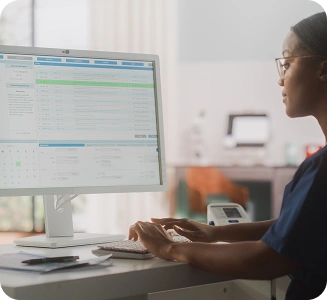When Equality Health Care Team Nurse Rachel Jozaites first met Becky, a 36-year-old Native American woman with a history of alcohol abuse, Becky’s liver was failing.
“She was so ill, I thought she was going to die,” Rachel said.
Becky hadn’t been to a primary care physician in years, but was admitted to the hospital three times between July and August. It was after her second hospital visit, when Becky left the hospital against the advice of the medical staff, that Rachel was notified to reach out and help. “In addition to the alcohol abuse, she had a number of health problems, including depression,” Rachel said.
Becky’s sister had recently died from liver failure, and alcoholism.
When the Emergency Department Becomes a Revolving Door
Becky repeatedly sought care at the Emergency Department (ED) due to fluid retention and the effects of toxin accumulation in the bloodstream. She experienced painful swelling in her feet, legs and abdomen. The white blood cell counts were also significantly out of normal range.
“It’s common for liver failure patients to frequent the emergency department,” Rachel said. “They usually go to the ED, get fluid drained off and medications to help expel those fluids. But Becky had never been given treatment for her other chronic conditions.
“When people leave the hospital against medical advice, you don’t get discharge papers, medication, follow-up care instructions, etc., so people end up being readmitted and still very sick.”
Third Time’s a Charm
Becky was so sick, Rachel told her, “If you don’t go to the hospital, you’re at risk of dying.”
On Rachel’s advice, Becky was admitted to the hospital for the third time, and was told she had to be cleared before she could leave. Rachel said, “There’s a reason why you’re not discharged. You’re not stable enough to be home!”
Rachel discussed Becky’s plan of care with her social worker at the hospital, and explained that she’d never been given any medication to help manage her condition.
Making Primary Care a Primary Strategy
As an AHCCCS patient, Becky was originally auto-assigned to a primary care group. She never thought to make an appointment.
Rachel met with Becky and assigned her to a new primary care doctor, but Becky cancelled the five appointments she made for her. In an attempt to motivate her to go and do something about her poor health, Rachel was calling Becky three to four times a week.
“I told her, ‘I can’t want you to get better more than you want to get better for yourself,’” Rachel said.
“Even though she kept cancelling, I told her I’m here for her. She started crying and said she really appreciated my help. She said she’d go see the primary care doctor if I would go with her.”
Rachel attended the appointment and got Becky established with a doctor and behavioral health specialist. Becky also got all of her medications appropriately adjusted, and was referred to a liver specialist.
“They were going to make her wait six weeks for the appointment but when I explained her condition, they moved it to just two weeks out,” Rachel said.
“Sometimes just having us call providers for the patient can move things up. We help them navigate the system,” Rachel said. “With me advocating for her, Becky’s primary care physician became more engaged, understanding that we are a team.”
They’ll Never Care How Much You Know
Until They Know How Much You Care
During in-home follow-up meetings, Rachel said she did a lot of education with Becky and her husband around disease management and infection prevention. The Equality Care Team Chaplain, Cesar Tellez, also provided the couple with ongoing spiritual and emotional support.
“Cesar prayed with them a lot. If you’re depressed, you’re not motivated to take care of yourself,” Rachel said.
For Becky, the care team efforts made a difference.
“I did a home visit and just from the increase in her water pills and wound care for her foot, her swelling went down significantly. She was actually smiling and joking for the first time—a welcome change from other appointments where she was crying,” Rachel said.
Planning for a Brighter Future
Rachel said she’ll be connecting Becky with a case manager from her insurance—Care1st—so she gets a long-term plan to help her manage her condition and avoid the emergency department.
Rachel said she feels confident that Becky will get the help she needs. “Now that she sees a path forward, I believe she’ll continue with her treatment plan. The face-to-face interaction was a big help to her. We visited her at the hospital, the doctor’s office and at her home.”
“The combination of patient advocacy and collaboration between our Care Team and physicians resulted in success,” Rachel said.
“Many of our members need a lot of handholding and Becky is not unique. One-size-fits-all care actually doesn’t work! The complex healthcare system often neglects the human connection. People want to know somebody cares about them,” Rachel said.
“If I hadn’t called Becky, she would have fallen off everyone’s radar and probably died.”




